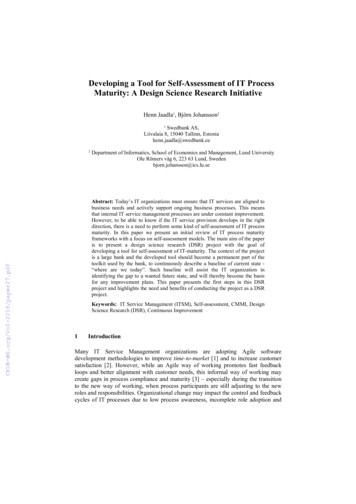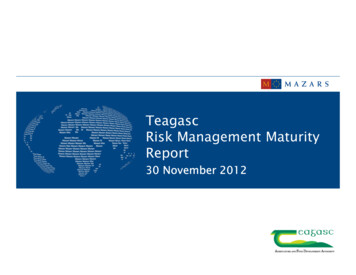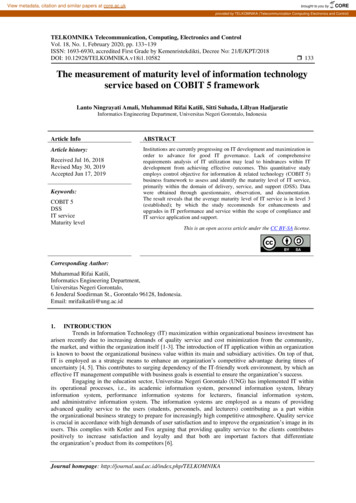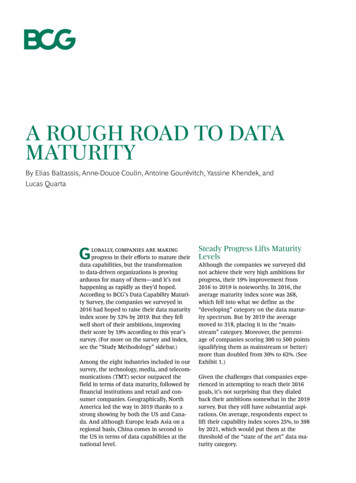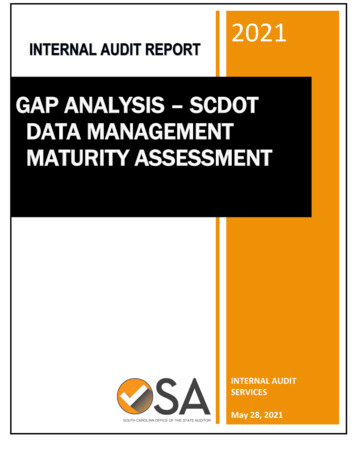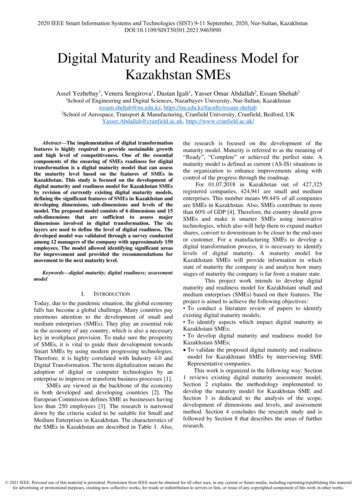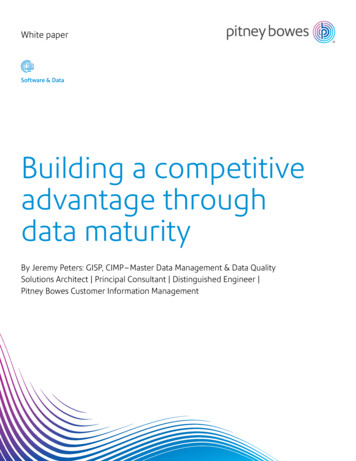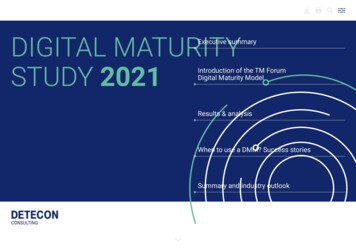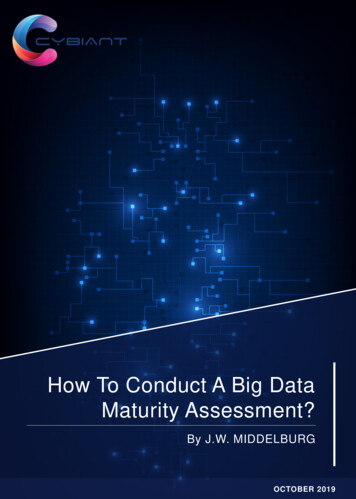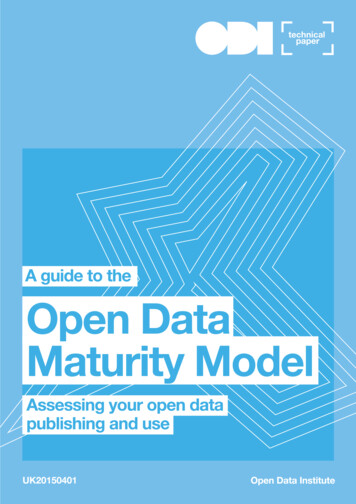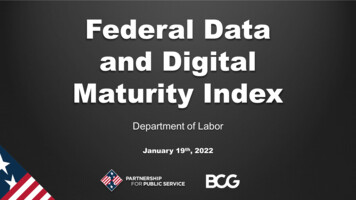
Transcription
Federal Dataand DigitalMaturity IndexDepartment of LaborJanuary 19th, 2022
Background and Discussion GoalsBackground and Recap The Federal Data and Digital Maturity Index(FDDMI) covers 29 baseline dimensionswith a focused view on Human Capital Results shown are for 41 total respondentsacross DOL, including DO/HQ and variousbureaus (e.g. BLS) Each dimension in the results correspondsto a question in the survey – results shownare simple averages of responses for agiven dimensionMeeting Goals and Objectives Initial debrief discussion to review top lineresults and discuss key takeaways Identify priority dimensions or topic areasfor follow on discussion and assessment Discuss accomplishments to date, currentand planned initiatives contributing toresults Facilitate an open discussion to gatherfeedback on survey process and unpackvaluable insights based on results
Recap The survey measures data and digitalmaturity across 29 dimensions & human capitalData and Digital outcomesDigital man capital deep divePeople strategyTalent acquisitionPeople developmentMission &strategyData andAnalyticsModularTechnologyDynamicPlatform Org.DigitalTalentPerformance, rewards,and engagementLeadership & culturalchangeLabor & employee on
Labor Results: Executive SummaryTopline Results3775Labor currentmaturity score(Fed avg 36 )Labor targetmaturity score(Fed avg 74)Priority Dimensions forinvestment1. World Class TechnologyFunction2. Modularity3. Service DeliveryKey TakeawaysLabor's strengths and highest ambitions are concentrated on tech dimensions –potentially undervaluing human and outcomes componentsLabor's core mission and strategy scores are in line with those across dimensions,indicating success in translating strategy to actionLabor's weakest maturity and importance scores mainly fall within outcomes relateddimensions – translate tech advancements to citizen offeringsLabor's largest ambition gaps to close and importance scores fall within modulartechnology dimensions, building on current leading capabilitiesLabor's current data and analytics capabilities exceed Fed averages and targetmaturity excels in procurement and modularity
We gathered a diversity of perspectives fromstakeholders across LaborOffice of theChief Data OfficeOffice of theChief InformationOfficeOffice of ChiefTalent Or HumanCapital OfficeAdministration &ManagementOfficeExecutingDepartments[ 3 ] people[ 3 ] people[ 6 ] people[ 2 ] people[ 27 ] people
Recap The survey measures digital maturityacross 4 maturity ratePerformerLeaderUnclear Digital visionClear vision/strategy &roadmap definedStrong digital mindset andagile cultureInitiatives are contributing to strategywith a clear value addedProcesses are beingdigitized but executed infunctional silosBusiness and IT have jointlybuilt key Digital capabilitiesacross all areasDigital has been embeddedthroughout the organizationDigitally enabledgovernance in placeDigital initiatives are built &implemented with successBusiness and IT sometimeswork on digital topicsOrganization not yetdigitally enabled10%17%Benchmark Legend:34%39%Global Private Sector Companies42%35%Global Public Sector AgenciesOutperforms peers in key digitalmetrics14%9%
Survey results provide layers of detaileddata for decision-makers1Top-line scores (current and target) for Labor2Top-line scores (current and target) for US Government overall3Prioritization of dimensions by current/target gap and importance4Labor scores by dimension by department5Labor scores by dimension and full demographic break-downs6Summary benchmark scores to overall private sector7Detailed benchmarks to overall private sector, by dimension and demographics8Detailed benchmarks to private sector peers, by dimension and demographics9Insights on priority focus areas and potential interventions10Full raw data from Labor surveyPreviewedbelowAvailable forfuturediscussions
Primer: Interpreting Labor Survey Results1Overall score,plotted along theFDDMI continuumrelative tobenchmarks42Labor focusedresults for currentand target maturityacross dimensions53Human CapitalDeep Dive scores –current and aspiredcombined view6Summary of Laborscores andimportance bydimension, relativeto federalbenchmarksSummary of Laborcurrent/aspiredscores compared tofederal averagesIdentifies priorityenabler areas forLabor to focusattention based onsurvey results
Labor aspires to become a Data and Digitalleader by 2025 – in line with Fed averagesStarterData l Target MaturityLabor, Target MaturityGlobal Private Sector (Current)Labor Current MaturityGlobal Public Sector (Current)Federal Current Maturity Often unclear visionIsolated initiativesOrganisation not yetdigitally enabling Clear vision/strategyRoadmap definedDigitally enablinggovernance in place Key data and digitalcapabilitiesDigitalised processesStrong digital mindsetand agile culture Data and digitalvisionariesDigital firstgovernmentsMost citizeninteractions digitizedData &digitalmaturity
Labor is currently digital literate, excelling indata & analytics dimensionsData and Digital outcomesDigital Government ExperienceDeliveryRe-imagine Government30Customer Journeys41Procurement34Innovation36Outreach & Communications30Service Delivery25Prototyping36Personalization36Enterprise Functions29Collaboration37Customer Services23Digital Ecosystem Operating ModelData and Analytics47Data Strategy39Digital & Data Platforms38Data Governance51Cybersecurity30Artificial Intelligence61 Sharing Data with PublicModular Technology43Strategic Vision & Ambition45Priorities and Alignment39Roadmap43Policy Development36New Leadership Models49Data Leadership & Culture28HumanTalent Ecosystem283346Agile at Scale34Modularity22BudgetingSource: FDDMI survey; n 41 for LaborTop 10 dimensionsby importanceData & digitalmaturity scoreExponential LearningDynamic Platform OrganizationWorld Class Tech Functionxx37Digital TalentMission & iteratePerformerLeader25-32 33-40 41-4950-57 58-65 66-7475-82 83-90 91-100
Labor aspires to become a digital leader,driven by modular tech and digital talentData and Digital outcomesDigital Government ExperienceDeliveryRe-imagine Government69Customer Journeys85Procurement72Innovation70Outreach & Communications75Service Delivery59Prototyping72Personalization76Enterprise Functions64Collaboration67Customer Services57Digital Ecosystem Operating ModelData and Analytics84Data Strategy84Digital & Data Platforms79Data Governance87Cybersecurity69Artificial Intelligence85 Sharing Data with PublicModular Technology77Strategic Vision & Ambition82Priorities and Alignment75Roadmap83Policy Development73New Leadership Models84Data Leadership & Culture70HumanTalent Ecosystem658876Agile at Scale89Modularity65BudgetingSource: FDDMI survey; n 41 for LaborTop 10 dimensionsby importanceData & digitalmaturity scoreExponential LearningDynamic Platform OrganizationWorld Class Tech Functionxx75Digital TalentMission & iteratePerformerLeader25-32 33-40 41-4950-57 58-65 66-7475-82 83-90 91-100
Labor hopes to become a human capitalleader with a focus on org transformationCurrentCurrent humancapital scoreAspiredPeople Strategy3365People Strategy30Talent Acquisition34Talent Acquisition68People Development36People Development69Performance, Rewards, and Engagement30Performance, Rewards, and Engagement66Leadership & Cultural Change36Leadership & Cultural Change74Aspired humancapital scoreOrganizational Transformation31Organizational Transformation7469Data & digitalmaturity scoreSource: FDDMI survey; n 41 for 32 33-40 41-4950-57 58-65 66-7475-82 83-90 91-100
Labor's Technology and Human componentshave the largest ambition gap to closeFDDMI building ission & strategyHumanLeaderImportance110083Digital Government Exp.69Delivery792Re-imagine Government611Data & Analytics813Modular Technology8978Digital Talent4Dynamic Platform Org.Labor currentFederal Gov. TMFederal Gov. CMLabor target1. Self-assessed importance level based on a scale of 1 (low) to 5 (high)Source: FDDMI survey; n 41 for Labor ; n 8 for Federal govt1234569Strength todayWeak areas todayLargest gap to close between current and ambitionLarge gap from ambition, but lower relative importanceLowest importance scores5
Labor's current maturity is slightly above Fedaverages, with strengths in data/analyticsLaborFederal AverageData and Digital outcomesDigital Government ExperienceData and Digital outcomesDeliveryRe-imagine GovernmentDigital Government ExperienceDeliveryRe-imagine Government30Customer Journeys41Procurement34Innovation32Customer Journeys36Procurement34Innovation36Outreach & Communications30Service Delivery25Prototyping34Outreach & Communications36Service Delivery28Prototyping36Personalization36Enterprise ise Functions37Customer Services23Digital Ecosystem Operating Model35Customer ServicesData and AnalyticsDigital & DataPlatforms47 Data Strategy3938Data Governance51 CybersecurityArtificial30 Intelligence61Sharing Data withPublicModular Technology43Strategic Vision & Ambition44Strategic Vision & Ambition45Priorities and Alignment45Priorities and Alignment39Roadmap43Policy DevelopmentMission & strategyVSDigital Talent36New Leadership Models49Data Leadership & Culture28Talent EcosystemTechnologyData and AnalyticsHuman28ExponentialLearningDigital & DataPlatforms44 Data Strategy3436Data Governance48 CybersecurityArtificial28 Intelligence54Roadmap39Policy DevelopmentCollaborationDigital Ecosystem Operating Model36New Leadership Models43Data Leadership & CultureDigital TalentMission & strategySharing Data withPublicModular TechnologyDynamic Platform Organization41302327Talent EcosystemTechnologyHuman25Dynamic Platform Organization33World Class Tech Function46Agile at Scale37World Class Tech Function42Agile at gCurrent score37Government scoreData & digitalmaturity scoreSource: FDDMI survey; n 41 for Labor ; n 8 for Federal PerformerLeader25-32 33-40 41-4950-57 58-65 66-7475-82 83-90 91-10036
Labor's target maturity exceeds Fedaverages, especially in procurement andtechnology dimensionsLaborFederal AverageData and Digital outcomesDigital Government ExperienceData and Digital outcomesDeliveryRe-imagine GovernmentDigital Government ExperienceDeliveryRe-imagine Government69Customer Journeys85Procurement72Innovation73Customer Journeys74Procurement72Innovation70Outreach & Communications75Service Delivery59Prototyping71Outreach & Communications79Service Delivery62Prototyping72Personalization76Enterprise ise Functions67Customer Services57Digital Ecosystem Operating Model70Customer ServicesData and AnalyticsDigital & DataPlatforms84 Data Strategy8479Data Governance87 CybersecurityArtificial69 Intelligence85Sharing Data withPublicModular Technology77Strategic Vision & Ambition79Strategic Vision & Ambition82Priorities and Alignment79Priorities and Alignment75Roadmap83Policy DevelopmentMission & strategyVSDigital Talent73New Leadership Models84Data Leadership & Culture70Talent EcosystemTechnologyData and AnalyticsHuman65ExponentialLearningDigital & DataPlatforms83 Data Strategy8179Data Governance86 CybersecurityArtificial70 Intelligence79Roadmap77Policy DevelopmentCollaborationDigital Ecosystem Operating Model74New Leadership Models82Data Leadership & CultureDigital TalentMission & strategySharing Data withPublicModular TechnologyDynamic Platform Organization77646169Talent EcosystemTechnologyHuman65Dynamic Platform Organization88World Class Tech Function76Agile at Scale82World Class Tech Function74Agile at gAspired score75Government aspiredscoreData & digitalmaturity scoreSource: FDDMI survey; n 41 for Labor ; n 8 for Federal PerformerLeader25-32 33-40 41-4950-57 58-65 66-7475-82 83-90 91-10074
Labor responses show six prioritydimensions based on importance andmaturity gapPriority areas are those that Laborindicated are most important, but lagfurthest behind their ambition.Labor Priorities Dimension Identified:(additional details in Appendix)ModularityData and DigitalPlatformWorld Class system
Labor can engage in focus groups and annualsurvey rounds to maximize valueFollow on discussionswith topic experts withmore detail on prioritydimensions and actionablerecommendations toaddress identified painpointsFocus group discussionswith other participatingagencies to share insightson survey learnings andbest practices acrossgovernmentUpdated federalgovernment average dataas respondents increase;future rounds of surveycompletions to assessmaturity progression, etc.
APPENDIX: Priority Dimension AdditionalDetails
Platform modernization links IT to valueand enables flexible & lower-cost platformsIndustry X.0ExperienceEconomyPersonalisationNext gen.engagementE2E DigitalJourneyDigital SCMCoordinate the customerjourney across all touchpointsUse Case CentricExperience LayerSystems of innovation to orchestrate customer journeysfor seamless UXBest-of-BreedBest of Breed systems todeliver lean processes at scaleDifferentiatingSystems of differentiation toincrease public valueModernised core to deliver non-differentiating processes withefficiency, compliance and stabilityData PlatformMaintain pace and demonstratevalue through leveraging dataLegacy ComponentsEncapsulate, contain, andgradually decommission legacycomponentsSingle System of Insight to bridge ‘insight-to-action’ gap and governdata creation and consumption, centrallyCo-exist with platform for phased migration over timeEnabling and EmergingCapabilitiesAPI IntegrationCover high-value gaps withmore flexible best-of-breedappsCreate personalised anddifferentiating digital apps andservice journeysLean CoreIoT HubReduce cost at the core bysimplifying back to a lean andvanilla stateCybersecurityDevOps ToolchainCloudAI/RPAContainerisation
DDP approach takes a mental flip: linkstrategic priorities with the digital WHAT andthen combine it with the HOWCore elements of the overall DDP roadmapWHYWHATHOWApproachExisting business strategyI Improvecitizen VResilient andfuture proofV Sustainability &ResponsibilityDigital use cases driving valuePolicyData & digitalplatformsService design &innovationServicedevelopment &implementationOrganizationand peopleService deliveryand supportGovernanceUnderstand tech & digital levers to reimagine and accelerate the strategicprioritiesIdentify and prioritize tangible digital usecases that drive value using: Digital maturity assessment Best practice benchmarks Pain points along key customergroups and employee journeysDerive the right target technology,organization and execution model to deliverthose digital solutions at scale whilst payingoff past debt
Myriad opportunities exist for public sectorentities to leverage digital and technologyPolicy, new services& business modelsCitizen experiences& service deliveryOperations Evidence-based policies (data-informed& adaptable policies through the use ofdata & AI) Personalized and Proactive ServiceDelivery Always-on Transformation (timelyresponse to the ever- changingenvironment & needs) Augmented Decision Making(augmented intelligent systems in dailytasks) Joined-up services designed aroundcitizen life events Public Infrastructure and AssetOptimization (data-informed investmentdecisions) Government as a Platform (serviceexpansion through collaboration withthe broader ecosystem) E-Participation (proactive engagementof citizens in decisions making andrunning of government) that's open,transparent and ethical Procurement and other Digital SupportFunctions (end-to-end digitalization ofback-office processes eg. HR, Finance)
A unique DDP architecture enables valueoutcomes with modularity, flexibility,scalability, speed & securityModular architecture with microservicesallowing reuse and easy adaptationData LayerCore Transaction LayerInfrastructure LayerCybersecurity & PrivacyAPIsIntegration managementSmart Business LayerExposure of data and services via APIsfor flexible access to build new use cases—data and services built onceData and analytics platform to decouple corefrom digital and provide value-addingcapabilities (e.g., AI, ML)Lean core systems for solid and stable backend processesCloud services and autom. provisioning forscalable infrastructure backboneCybersecurity and privacy is embedded acrosslayers to unlock full DDP potential
Moving from monolithic systems tomodular architecture liberates thedata & supports new technologies Current complex landscapeTo be: A Digital and Data PlatformOmni-channelsService centerOmni-channelsOtherService centerDigital ERPCRMhybris Core systemsKLTPS Legacy systems Mobile appWebsiteOtherCross-channel mechanisms and business componentsPersonalisationDataContact CenterEligibility engine Jr. orchestration ERPWorkflow ex. TransactiondataCitizen dataData lakeSearch CRMDWHTPSSecurityMobile appAPI ManagementSitefront-end
Key ingoing question: What are youoptimizing for?IT Efficiencyand CostAgility andBusiness ValueDigital Capabilitiesand CultureStability andSecurityWhat is the right target ITcost level for your company?What is the right future IT orgstructure (e.g., Numberlayers, span of control)?How to ensure that theIT/Tech workforce isequipped with the right digitaland tech capabilities?How to successfully combineoperational stability withagility that meets and/orexceeds marketexpectations?How much to invest inchange to ensure futurereadiness?How to increase the share ofdirect/value-addingactivities?How to achieve effectivebusinessand IT collaboration?How to reducecomplicatedness in IT and atthe interface of business andIT?How to ensure that theIT/Tech function is able torecruit and retain talent?How to incorporate securityby design in IT services andapplications to mitigaterisks?
To build a World Class Technology Function,need to increase digital capabilities andresilience/simplification. to build a World Class TechnologyFunctionLowStability & Security ImprovementneedCapabilities & CultureWorld ClassTech functionDigitalcapabilitiesLowAgility & Business Value Digital focusEfficiency & Cost High Enhance digital capabilities andresilience/simplification .Resilience/Simplif. focusHighResilience/Simplification
Specific levers to build a World ClassTechnology FunctionLevers to boostDigital capabilitiesLevers to boostResilience/Simplification1Application, data, ITinfrastructureBuild a modern data and digital platformembracing digital design patternsSimplify application, data and IT infra. landscapeby reducing redundancies and number of platforms2Operating model &Bus./Tech collaborationImprove business tech collaboration byapplying agile ways of workingSimplify IT/Tech organization, governance andprocesses end-to-end3Workforce,leadership & cultureBuild world class tech and engineeringcapabilitiesIncrease workforce effectiveness by shifting fromindirect to direct activities and selective insourcingof critical skills4Sourcing& EcosystemBuild the digital ecosystem and enhanceagile sourcingSimplify supplier portfolio and improve suppliermanagement5CybersecurityImplement de-risking of agile delivery andestablish security end-to-endPrevent, detect, respond, and recover from cyberattacks6Digital product& operational TechBecome a player in digital productand service technologyRealize synergies by combining IT and OT wherepossible
DACAMA is based on the Data Capabilitiesframework (aka “the pyramid”)Leadership, change & enablementData Capabilities FrameworkVisionKey issues to address (simplified) Why are we interested in data? What are we trying to achieve? Improvement of current practices or radical transformation?Use cases Which are the main macro use-cases? How much value/ do we expect from each? Do we have the right end-to-end ownership and accountability for our use cases?Analytics Set-up Do we have the right talent pool? Have we implemented the right analytics functions? Do we have a thorough analytics process, leading to concrete results?Data GovernanceData PlatformEcosystem & Partnerships Do we have in place a Data Management organization? Have we launched basic Data hygiene actions (incl. defining quality and KQIs)? Do we have an infrastructure suitable to our vision and future use cases (incl.technologies and operating model)? Is it end-to-end (modeling- industrialization)? Do we understand and leverage the data ecosystem around us? How should we manage the ecosystem? What role should we play in it? How do we handle change management from legacy to a data-driven company? Do we leverage the new ways of working?
Fully leveraging Data requires severalcapabilities working together in a cohesiveoperating modelLeadership, change & enablementData Capabilities FrameworkVisionUse casesData Governance is a fundamental data capabilityAnalytics Set-UpData GovernanceData PlatformEcosystem & Partnerships Do we know the value that good data quality represents for us?Do we have a trustworthy and useful description of our data?Have we defined and measured current data quality?Have we launched basic Data hygiene actions?Do we have a set of data policies adapted to our needs?Do we have in place a data governance organization
Data governance must cohesively integratewith other capabilities to drive value fromdataType of issues if delivered individually Data Governance brings solutions Analytics use cases industrialization isconstrained and remains at PoC stage dueto e.g., Access issues to the Data within the legacy Misunderstanding related to master andreference data Biased results due to lack of data quality(freshness, granularity, accuracy or integrity)VisionUse casesAnalytics set-upData Governance IT-driven architecture projects often fail todeliver ambitioned results by lack of e.g., Data sourcing strategy (identification of theright source, ingestion patterns,transformation rules, exposition needs, ) Data migration plans (business priorities notconsidered and value of new technologies notgrasped timely enough)Data PlatformEcosystem & PartnershipsData capabilities modelBy remaining pragmatic and avoiding the “Ministry ofData” trap, data governance identifies and deploysthe right organization, roles, policies and tools inorder to ensure Data access in line with business needs(validated across the agency) A single point of truth for all master andreference data objects (data dictionary andmetadata repository) A high level of quality of main data objects (viaprioritized and efficient data hygiene actions) Data mapping by business domains Allocated responsibilities on key datasetsto ensure quality and consistency of therelated data Data tracking and understanding of datausage by the business (functional and technicaldata lineage) Privacy, regulatory and security compliance
Government Service Delivery FrameworkGovernment servicedelivery objectivesEnablersBusiness modelChannelsOperating modelDimensions ofgovernment servicedeliveryObjectives and vigationalservicesPhysical points of presenceDriving andcoordinatingcitizen ngplatformsContact CentresDriving digitalmigrationDigitalTechnological enablers and platformsGovernanceFundingStructure and processesCulture, leadership and talent
There are a wide range of dimensions ofgovernment service alservices requirean exchangebetweengovernment andcustomer. Thereare a variety oftypes, and eachdiffer incomplexity,sensitivity anddeliveryDeliveringnavigationalor advisoryservicesDriving andcoordinatingcitizen journeyprojectsNavigationalservices help steercustomers throughgovernmentprocesses, makingit easier totransact andinteract h customerjourney projectsbreaks the tradeoff between costand customerexperienceBeing afunctionalacceleratorBeing a centre ofexcellence forservice deliveryand provingleadership, bestpractices and/ortraining for othergovernmententities in specificfunctional arease.g. roboticprocessautomationBuildingplatformsDriving digitalmigrationBuild and managestandard ICTsolutions/platformsthat enableservices to be builtand modifiedquickly and atreduced riskDrivegovernment'sdigital agenda byvigorously pushingservice deliverytowards onlinechannels
These challenges are exacerbated bycustomers’ rising expectations of howgovernment services should be deliveredHorizons for using digital technology in service delivery transformationCURRENT EMPHASISRECENT FOCUSRising customerexpectation for simple andseamless cross-channelexperienceIntelligent automationapplied to optimise manualintensive processesDigital identity as a gamechanger by enablingwidespread ‘tell-us-once’approachCustomer journey-ledservice design around keylife eventsDigital technologies utilisedto boost social inclusion fordisadvantaged communitiesSophisticated use of socialmedia for analysingcustomer sentiment and forcommunicating brandpersonalityCustomers expect to be able totransact efficiently throughchannel of choice (usuallydigital preferred)Customers expect a highquality end-to-end experiencethat seamlessly meet theirneedsEMERGING HORIZONProactive and personalisedservices based onintegrated customer dataArtificial intelligencedelivering high qualityrecommendations anddecision-making inputSustain ideas generationand customerempowerment throughplatform-based crowdsourcingCustomers expect servicestailored to their specific needsand context, more proactiveand more personalized
Three step approach to improving digitalskills and attracting digital staff inyour agencyIdentify current skill gaps through strategicworkforce planningUnderstand future capability demandrequired to deliver the digital transformationstrategyDevelop a baseline skills map to understandcapability supplyAnalyse gaps between desired capability andcapability demandClose skill gaps through training,acquisition and redeploymentIdentify capabilities that can be trained orneed to be acquiredClose skill gaps by focusing on thefollowing areasRecruiting digital skillsTraining and PathwaysSkill redeploymentChange the way your agency approachesdigital skillsBuild in measurement systems to track thedigital skills in your organisationUse analytics to understand skill gaps toinform hiring and trainingDevelop real time performancemanagement platformsReform back end governanceand processes to allow forworkforce flexibilityOngoing people retention effortBuild in system for feedback (e.g.,engagement measurements, exitinterviews, pulse checks)Change governance and processes to beable to respond to feedbackDevelop an environment where staff withdigital skills feel supported and empowered(e.g., through new waysof working)
Three step approach to improving digitalskills and attracting digital staff inyour agencyIdentify current skill gaps through strategicworkforce planningDoes you agency know the key digitalcapabilities required to implement thedigital strategy?Do you have an understanding of whatthe current capabilities of your staff are?Do you understand where the priority skillgaps that need to be filled are?Close skill gaps through training,acquisition and redeploymentIs there a clear training plan, includingidentified staff?Does your agency know what makes aorganisations attractive for people withdigital skills?Are there any staff whose skills would bebetter utilised in another part ofthe agency?Is there a system in place to trackimprovements in capability?Change the way your agency approachesdigital skillsDoes your agency have the capability totrack staff skills and capability needs inreal time?Do staff have the ability to easily moveacross the agency to where their skillsare best used?Have people in your agency hadexposure to private sector digital skills?Ongoing people retention effortDoes your agency understand the drivers ofemployee dissatisfaction?Does your agency have the ability torespond to employee dissatisfaction?Is your agency one where staff feelsupported and empowered by leadership?
Six high value actions you can takeimmediately to start improving your digitalskills and attracting digital people1Understandcapabilities requiredWrite a short term skills map that details the core capabilities required to deliver plannedinitiatives over the short term2Focus on hiring people withdigital skillsRefocus hiring efforts through channels where people with digital skills are, as well as makingdigital positions more attractive3Offer flexibility to move todigital programsAllow staff with demonstrated expertise in digital to self-select into project teams that requiredthose digital skills4Expose people to digitalMove high performers into areas of the agency that are working in digital, to create exposureand understanding of digital to the next generation of leaders5Offer digital trainingand secondmentsProvide digital training and secondments to digitally mature agencies to provide theopportunity for staff to develop their skillsets in digital6Start creating asupportive environmentCreate an environment where people can thrive by introducing agile ways of working andem
Data & digital. maturity Often unclear vision Isolated initiatives Organisation not yet digitally enabling Clear vision/strategy Roadmap defined Digitally enabling governance in place Key data and digital capabilities Digitalised processes Strong digital mindset and agile culture Data and digital visionaries
